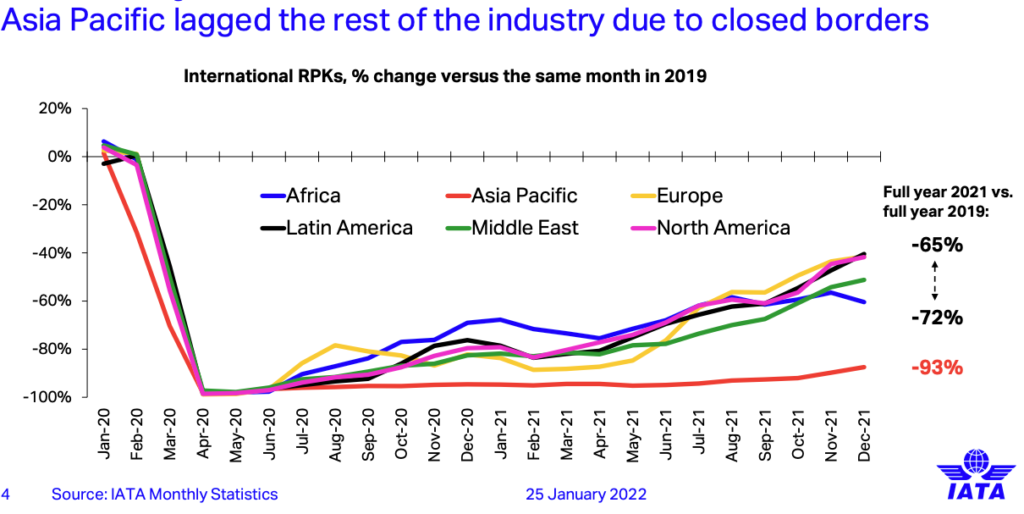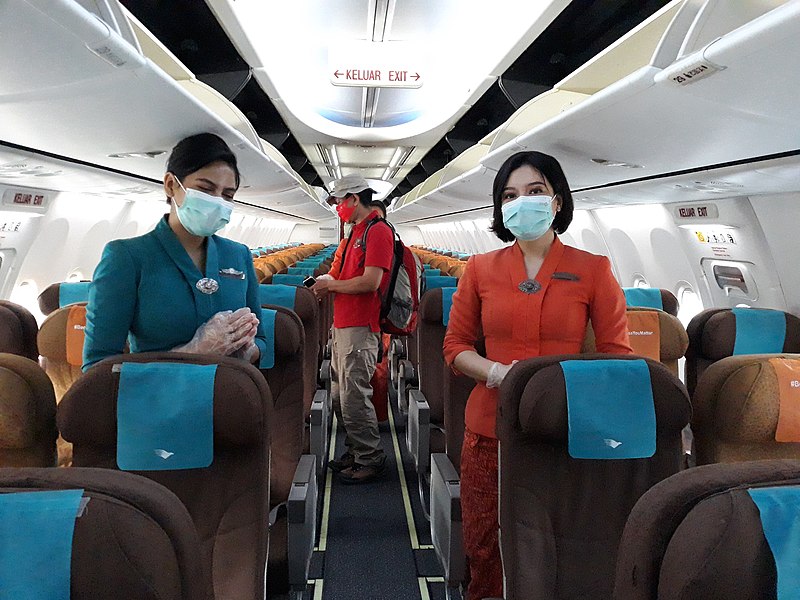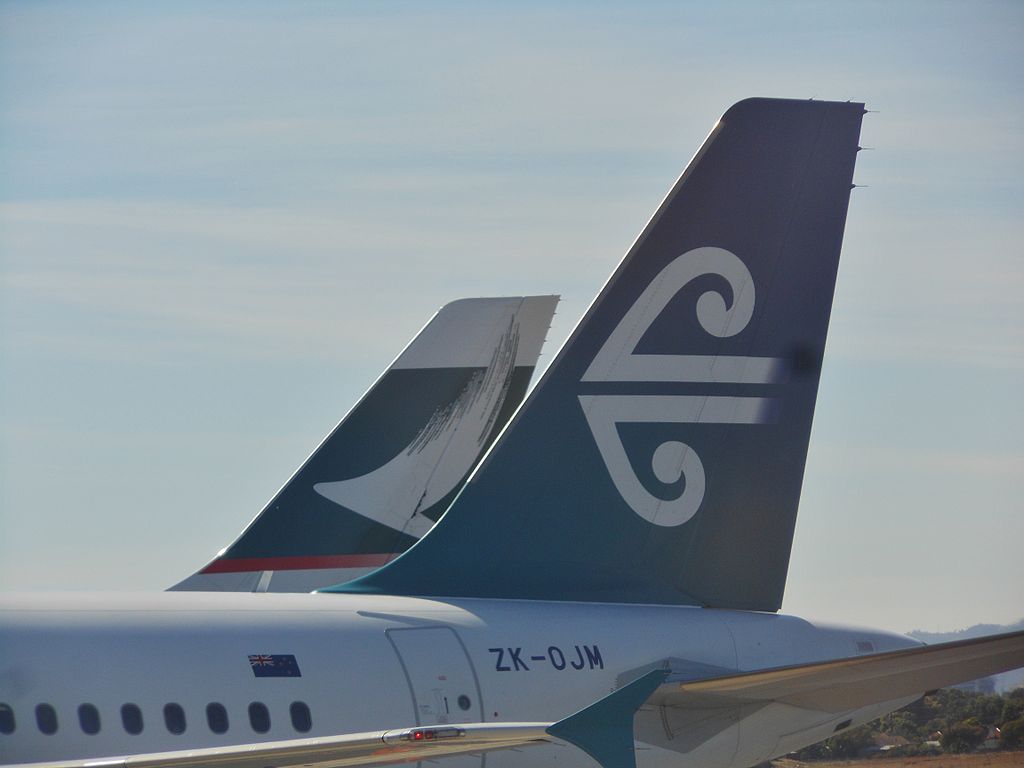Navigatus has reviewed the impact of COVID-19 border controls for aircrew in the Asia-Pacific region. The New Zealand Ministry of Foreign Affairs and Trade commissioned the research for the Asia-Pacific Economic Cooperation (APEC). In December 2020 the APEC member economies adopted the report and it was published by the APEC secretariat. The Navigatus report can be found in full here.
The COVID pandemic has had a huge impact on the aviation sector. The Asia-Pacific region was hardest hit by COVID and has been the slowest to recover – see figure below.

The COVID-19 pandemic has severely disrupted cross-border travel. Many economies
locked down their borders with little travel between them. As vaccination rates have
increased economies have implemented requirements and procedures such as proof of
vaccination, testing requirements checking for COVID-19, quarantine and isolation. These requirements and procedures differ from economy to economy and hinder the efficient passage of aircrew
Aircrew play a vital role by operating flights, maintaining safety and enabling air links to remain
in place. They are the ‘connective tissue’ of airlines, aviation systems, and air connectivity. Aircrew and their employers face the challenge of meeting divergent requirements and procedures at borders to control the spread of COVID-19. If these requirements were less varied it would allow carriers to operate more efficiently.
Why are COVID border controls for aircrew an APEC focus?
One of the main goals of APEC is to ensure that goods, services, investment and people move
easily across borders. So increasing harmonisation in the region around aircrew border controls is a key issue for APEC. The United Nations International Civil Aviation Organisation (ICAO) has published a number of guidelines, but they are not being implemented in any coherent manner across APEC economies.
Scope of Research
We explore why ICAO guidelines on crew management during COVID pandemic, such as these are not being implemented across APEC. We also looked at what might be possible to encourage greater harmonisation in the region.
As the research progressed it became clear that one single set of regulations for the APEC
region would not be beneficial. In part that’s because economies have large differences in the amount of COVID-19 in the community that the health care system can manage. They also have different
approaches to COVID-19 mitigation (e.g. elimination or suppression) and different initial
solutions to the rapid spread of the virus in 2020.
Rather than recommending a harmonisation of regulations, we recommended harmonisation of process. That allows each economy to tailor their border controls, but still provide a more harmonious and clear set of rules for aircrew and carriers to follow.

The health objective
Having a clear objective is the foundation of good risk management.
The World Health Organisation (WHO) says that the the overall health and wellbeing of communities should be at the forefront of considerations for international travel-related measures.
Minimum levels of air transport don’t achieve these health goals for most economies. For example, the overall health and wellbeing of communities depends on the transport of vaccines across international borders. In addition, millions of people across APEC economies rely on air-freight to distribute their products and services for their economic well-being. It is imperative for economies to work together to facilitate air transport with risk-based approaches. Facilitating the movement of aircrew is vital to this.
Harmonised approaches to border controls for aircrew
We recommended that economies adopt a harmonised suite of processes. The aims of
our recommendations are to protect public health, while maximising air services for the benefit of member economies and their populations.
Below we present or recommendations in priority order. We expect that those listed first will be relatively
easy to implement, and produce the most immediate benefits.
Nine recommendations for a safe return to open borders
Recommendation 1 – Be Well-informed
The first recommendation is to help ensure that economies have access to the best available information. An organisation already exists for that purpose: the Collaborative Arrangement for the Prevention and Management of Public Health Events in Civil Aviation (CAPSCA). CAPSCA sits under the ICAO umbrella and is free for economies to join and provides access to the latest research. This allows economies to set controls informed by the most recent and relevant risk information.
Recommendation 2 – Treat Aircrew Separately to Passengers
Recommendation 2 is about recognising that aircrew are operating in a formal risk management framework. This is consistent with the WHO guidance on a risk-based approach. It follows that aircrew are separated from the general public in terminals to avoid cross-contamination. Separation
of crew from passengers allows the application of border controls that are fit for purpose and proportionate to the risk.
Recommendation 3 – Prioritise Least Invasive Border Controls
Consistent with the WHO recommendations, apply risk analysis to routinely review border
controls for aircrew. When reviewing controls, ensure that controls are the least invasive
required to achieve the public health objectives.
Recommendation 4 – Improve Co-ordination Between Border Control Agencies
During the pandemic response co-operation between agencies at the border has become more patchy. This can lead to unexpected delays which are frustrating for carriers who need to get crew to their accommodation for rest periods. Member economies set up public health controls at their borders very quickly, so initial areas of friction are understandable. Now that health controls have become a longer-term fixture, improved co-ordination between health and other border agencies would enable more efficient airport operation.
Recommendation 5 – Consult with Carriers
Consult with carriers about proposed changes to controls. Carriers are often able to contribute suggestions. They are keen to find ways to keep the number of COVID-19 cases presented from air crew extremely low – while enabling efficient operation.

Recommendation 6 – Bilateral Consulting Between Economies
Consistent with the WHO recommendations, explore bilateral, multilateral and regional agreements across economies. The aim would be to facilitate the recovery of key activities for which international travel plays an important role. Examples include tourism and the movement of cross-border workforces.
Recommendation 7 – Adopt and Apply CART Recommendations
ICAO has already developed a set of relevant recommendations for economies, through the Council Aviation Recovery Task Force (CART). Applying the CART recommendations would help to enable efficient aviation operations, while preserving public health.
Recommendation 8 – Research
Research the effectiveness of COVID-19 border controls for aircrew and share with other
economies. Use results to inform risk-based policies. Each economy has unique factors,
so robust local research is needed. A small investment in research could help
economies to focus their border control efforts to where they are most effective.
Recommendation 9 – Share the roadmap
Bringing a plane out of storage and into service can take several months. Operators need to rehire crews and bring their currency up to date. Some crew will need training time in simulators to meet currency requirements.
Operators comment that they can’t plan ahead as there is no clear roadmap. Recommendation 9 is to provide a clear roadmap to all stakeholders. Carriers accept the things change, but it helps them to plan if they know the parameters. For instance, “when vaccination levels hit 90% then the following controls will be lifted”.
This will allow carriers to increase capacity sooner, through planning ahead. If member economies follow these recommendations, it is expected that greater usage of IATA, ICAO and CART guidelines will naturally occur. This is expected in turn, to result in increased harmonisation of aircrew entry requirements across APEC economies.
Conclusion – Reducing impacts of border controls for aircrew
We recommend a suite of measures to enable foreign-based aircrew to safely cross
economic borders and keep critical air freight connections open and efficient. The measures
derive from ICAO / CART recommendations and are consistent with the WHO risk-based
approach to pandemic response.
Our recommended approach recognises that economies require diversified approaches for managing
COVID-19, and are also at varying points of the pandemic life-cycle within their communities.
The suite of measures allows economies to select measures that are appropriate to their COVID-19 response strategy and for their stage in the pandemic lifecycle.
In the medium term we expect that all economies will return to more open borders. It is the
pace of reopening and the path forward that is at stake. The main benefits of the recommended
actions will be to reduce unnecessary friction at the aircrew / border interface, which acts as
a drag on economic activity. The flow-on benefits include more carriers operating, more flights,
lower air freight costs, more air freight moved, more local employment, and enhanced post COVID-19 recovery of domestic economies.
Acknowledgements
Kevin Oldham and David Spencer undertook the research. In addition, Justin Tighe-Umbers and Patrick Whelan of the Board of Airline Representatives New Zealand (BARNZ) ably assisted the Navigatus research team. The team consulted with the International Association of Air Transport Operators (IATA).
“We consulted closely with IATA as member airlines need to comply with these changing rules, so they have a good understanding of them. It’s great to see that, not only has APEC adopted the report, but IATA has subsequently picked up our report and is circulating it to relevant parties“, says the Project Director, Kevin Oldham.
About the Author – Kevin Oldham
Kevin Oldham is a director of Navigatus with a depth of experience in helping clients to achieve success in an uncertain context. A brief profile for Kevin can be found here.

Comments
No comments yet.